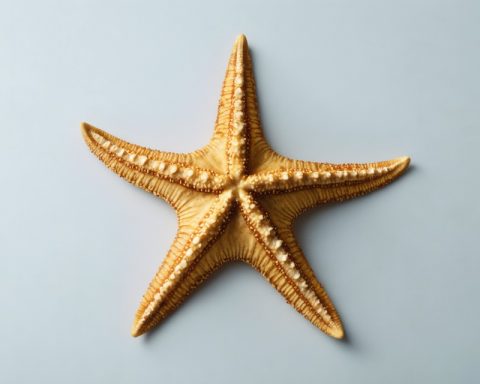- A starfish-inspired wearable device, developed by University of Missouri researchers, offers revolutionary advancements in monitoring heart health.
- Unlike traditional Doppler ultrasound, this device captures comprehensive heart activity data through daily use, offering multidimensional insights with SCG and GCG.
- The device utilizes accelerometers and electrodes to glean details about heartbeats and mechanical echoes.
- Smart algorithms process data from the device, achieving over 91% accuracy in distinguishing heart conditions such as atrial fibrillation and heart failure.
- Lightweight at only 1.7 grams, this prototype can monitor for up to eight hours before needing a wireless recharge.
- This innovation highlights the potential for simple design to enable complex functionalities, offering a promising advancement in personalized heart health monitoring.
A cutting-edge innovation is poised to revolutionize how we monitor heart health, drawing inspiration from the humble starfish. Imagine a device that clings gently to the chest, as unassuming as a whisper, yet packed with the sophistication of a dolphin’s sonar—this is the starfish-inspired wearable created by a team of forward-thinking researchers at the University of Missouri.
Traditional Doppler ultrasound, a time-honored method for cardiac assessments, requires stasis and a trip to the clinic, offering merely a snapshot of heart activity. It’s akin to judging a movie by a single frame. Enter the innovative starfish-inspired device, poised to change that paradigm by capturing a symphony of signals and pulsations throughout a person’s ordinary day-to-day life.
This remarkable gadget, a brainchild of Sicheng Chen, Zheng Yan, and their colleagues, mimics the dynamic flexibility of a starfish’s arm. Five elegantly designed arms extend from a central hub, each ending in a specialized sensing pad. Unlike current devices that resemble tangled ivy, sprawling across the chest, this streamlined unit adheres with the simplicity of a gentle touch, secured with a conductive gel. Imagine a starfish embracing your heart, attentively listening through accelerometers and electrodes nestled in its arms.
What sets this device apart is its holistic approach to data acquisition. It doesn’t just capture the electrical heartbeats like a traditional ECG; it records the heart’s mechanical echoes—seismocardiogram (SCG) and gyrocardiogram (GCG)—offering a multidimensional perspective on cardiovascular health. This is akin to shifting from a monochrome photo to a full-color, high-definition panorama.
Data rhythmically flows from the device to a nearby smartphone or tablet, where it is processed ten times every second by smart algorithms. These algorithms, trained on data from individuals both healthy and unwell, weave together patterns, deciphering ailments such as atrial fibrillation and heart failure with an impressive accuracy of over 91%.
Despite its complex capabilities, the prototype is feather-light, tipping the scales at a mere 1.7 grams. It can tirelessly monitor for up to eight hours before it thirsts for its wireless recharge. Future iterations promise even more comfort and breathability, allowing users to wear their cardiac guardian with ease, perhaps all day, heralding a new era in personalized medicine.
This breakthrough serves a key lesson: simplicity in design can yield complexity in functionality. Just as the starfish inspires awe through its straightforward yet highly effective form, this device promises a new trajectory in how we understand and maintain heart health—transforming ordinary care into something extraordinary.
Revolutionary Starfish-Inspired Wearable Transforms Heart Health Monitoring
Understanding the Starfish-Inspired Wearable Device
The starfish-inspired wearable device, developed by researchers at the University of Missouri, is poised to revolutionize heart health monitoring by providing constant, real-time data in the comfort of one’s own home, unlike traditional Doppler ultrasound, which requires a clinical visit.
Key Features and Functionality
– Bio-Inspired Design: Inspired by the starfish’s arms, the device houses five sensory arms with accelerometers and electrodes that capture comprehensive cardiac data. This strategic arrangement allows for easy adherence to the chest using a conductive gel.
– Multidimensional Data Capture: It records not only electrical impulses through ECG but also mechanical heart signals via seismocardiogram (SCG) and gyrocardiogram (GCG). This offers a full picture of heart activity much like shifting from a monochrome photo to a full-color image.
– High Processing Capability: With a feather-light design at 1.7 grams, the wearable transmits data to a smartphone or tablet at ten analyses per second. Sophisticated algorithms detect heart conditions such as atrial fibrillation and heart failure, boasting an accuracy of over 91%.
Benefits and Real-World Use Cases
– Continuous Monitoring: The wearable allows monitoring over extended periods of up to eight hours, potentially identifying issues that static ultrasounds may miss.
– Personalized Cardiac Care: Enables a tailored healthcare approach by continuously tracking changes, leading to more informed medical interventions for conditions like hypertension and arrhythmias.
– Increased Accessibility: Makes advanced cardiac diagnostics accessible outside of clinical settings, empowering individuals to take proactive roles in their health management and potentially reducing the need for frequent hospital visits.
Future Prospects and Industry Trends
– Extended Battery Life and Comfort: Future enhancements could increase wear time, improve device comfort, and integrate more data analysis features to improve user experience.
– Integration with Health Apps: There’s potential for integration with other digital health platforms, streamlining data sharing with healthcare providers.
– Wider Adoption: As wearable technology becomes more prevalent, these devices could become mainstream, driving advancements in remote cardiac care.
Addressing Potential Questions and Concerns
– Security and Privacy: Data encryption and secure transmission protocols are critical to protect sensitive health information.
– Market Impact and Pricing: While currently in a prototype stage, the device’s cost-effectiveness will be essential for broad adoption. Early indications suggest a focus on affordability to ensure wide accessibility.
– Comparative Effectiveness: Compared to traditional cardiac monitoring solutions, users gain richer, continuous data, offering a significant enhancement in diagnostic capability.
Actionable Tips and Recommendations
– Stay Updated: Keep an eye on developments in wearable health technology, considering adoption once the device becomes commercially available.
– Consult Healthcare Providers: Discuss the potential of using continuous monitoring devices with your healthcare provider, especially if you have existing cardiovascular concerns.
– Prioritize Data Security: Ensure any wearable device you use has strong privacy protections to secure your health data.
Conclusion
The starfish-inspired device signifies a bold step toward personalized heart health management. As we look forward to its broader application, it offers a profound glimpse into the future of preventative and personalized health care.
For further insights into wearable technology and other innovations in health monitoring, visit University of Missouri.















